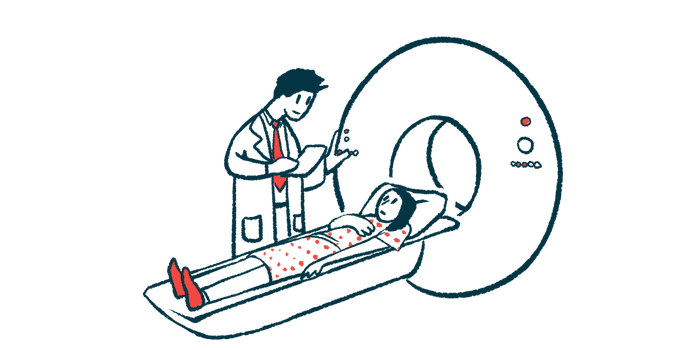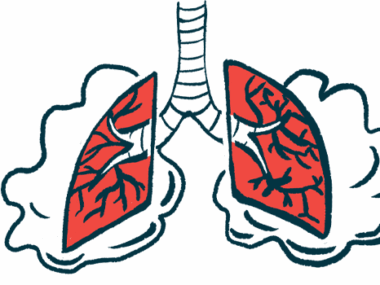Chest CT scan before transplant may predict survival after: Study
Muscle mass, bone density shown to be significant pretransplant predictors
Written by |

A chest CT scan taken before a lung transplant can help predict survival after the transplant in people with systemic sclerosis (SSc), a new U.S. study suggests.
Muscle mass, bone density, and the volume of the heart and blood vessels were among the “novel image features” of the pretransplant CT that best predicted a patient’s survival, according to the researchers.
Adding CT data to demographic and clinical characteristics improved the accuracy of survival prediction, but CT scans alone could also accurately predict posttransplant survival, the study found.
“Our individualized risk assessment tool can better guide clinicians in choosing and managing patients requiring lung transplant for systemic sclerosis,” the scientists wrote.
Their study, “Predicting post-lung transplant survival in systemic sclerosis using CT-derived features from preoperative chest CT scans,” was published in the journal European Radiology.
Investigating a CT scan of the chest as a possible prediction tool
In SSc, also called scleroderma, a mistaken self-directed immune response drives inflammation and scar tissue buildup, or fibrosis, in the skin and potentially the internal organs.
When the lungs are affected, the scarring makes it more difficult to breathe and can increase the risk of mortality, or death. In severe cases, a lung transplant may be indicated when other therapies have proven to be ineffective.
Lung transplant in SSc accounts for about 0.9% to 1.2% of all lung transplants. This may be due to the disease’s complex, multiorgan nature, which limits the number of clinical centers performing transplants in this patient population.
As such, “there is a pressing need for additional research to understand post-[lung transplant] survival factors and identify those who are suitable for this procedure,” the researchers wrote.
A CT scan of the chest is routinely performed before a lung transplant to assess the patient’s condition and disease and to monitor the individual’s health status. According to the team, such scans may also contain valuable information that may predict posttransplant complications and survival.
There is a pressing need for additional research to understand post-[lung transplant] survival factors and identify those who are suitable for this procedure.
To find out more, scientists at the University of Pittsburgh in Pennsylvania examined pre-lung transplant CT scans to identify features associated with posttransplant survival.
In total, the team examined pretransplant scans from 102 patients, 61% of whom were women. The researchers specifically looked at features related to body composition — bone, muscle, and fat — and the cardiovascular system, involving the heart, arteries, and veins. The patients’ characteristics and clinical features, both before and after surgery, were obtained from medical records.
Nearly half of the patients (49%) died before the end of the study period. One year after the surgery, 76.3% were still living, compared with 64.3% after two years and 52.2% after three years.
Higher BMI found to protect against mortality risk posttransplant
Regarding demographic factors, the most significant predictor of survival was the patient’s body mass index, or BMI — a ratio of weight to height that’s often used as a measure of body fat content — the study found. A higher BMI, or more body fat, was protective against mortality. Being of the African American race also demonstrated a protective effect compared with other races.
Clinical features associated with a higher mortality risk included more coexisting medical conditions adjusted for age, calcium deposits in soft tissue, known as calcinosis, and pulmonary arterial hypertension, or PAH, which is high blood pressure in the vessels that supply the lungs. Also, undergoing a posttransplant tracheostomy, a surgically-created hole in the windpipe, was linked with an increased risk of mortality.
Among the cardiovascular parameters measured by pretransplant CT scans, a higher artery-to-vein volume ratio was linked with extended survival, according to the study. A higher heart ratio, defined as the heart volume divided by the volume of the chest cavity, also was predictive of survival.
In terms of body composition, a higher bone density demonstrated a protective relationship with posttransplant survival. Similar results were observed for muscle mass ratio, defined as the mass of skeletal muscle (those attached to bones) divided by the mass of the body tissues in the chest. A greater muscle volume also emerged as a protective feature.
The researchers then calculated predictive models based on demographic/clinical characteristics, CT scan features, or both, which they dubbed the aggregate model.
With demographic/clinical characteristics, the accuracy in predicting posttransplant survival was 65% after one year, 75% after three years, and 84% after five years. When CT scan features were added, the aggregate model’s predictive abilities increased to 75% after one year, 83% after three years, and 90% after five years.
The model using only CT scan features outperformed the model that used demographic/clinical characteristics. Importantly, according to the researchers, the CT model also outperformed the aggregate model after one and three years, “indicating that CT features alone can serve as predictors in survival models,” they wrote.
“Our study sheds light on the potential of utilizing CT-derived radiographic features to predict post-[lung transplant] survival in SSc patients before they undergo [a lung transplant],” the scientists concluded.







